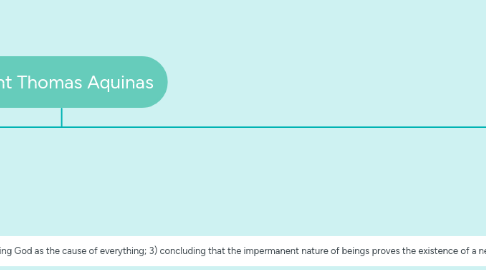
1. LIFE
1.1. Thomas Aquinas is the preeminent spokesman of the Catholic tradition of reason and of divine revelation
1.2. At five he was given to the Benedictine monastery at Monte Cassino in his parents’ hopes that he would choose that way of life and eventually became abbot. In 1239, he was sent to Naples to complete his studies. It was here that he was first attracted to Aristotle’s philosophy.
1.3. By 1243, Thomas abandoned his family’s plans for him and joined the Dominicans, much to his mother’s dismay. On her order, Thomas was captured by his brother and kept at home for over a year.
1.4. Once free, he went to Paris and then to Cologne, where he finished his studies with Albert the Great. He held two professorships at Paris, lived at the court of Pope Urban IV, directed the Dominican schools at Rome and Viterbo, combated adversaries of the mendicants, as well as the Averroists, and argued with some Franciscans about Aristotelianism.
2. CHURCH & LITERARY WORKS
2.1. He is one of the great teachers of the medieval Catholic Church, honored with the titles Doctor of the Church and Angelic Doctor.
2.2. His greatest contribution to the Catholic Church is his writings. The unity, harmony, and continuity of faith and reason, of revealed and natural human knowledge, pervades his writings. One might expect Thomas, as a man of the gospel, to be an ardent defender of revealed truth. But he was broad enough, deep enough, to see the whole natural order as coming from God the Creator, and to see reason as a divine gift to be highly cherished.
2.2.1. While teaching at Cologne in the early 1250s, Saint Thomas Aquinas wrote a lengthy commentary on scholastic theologian Peter Lombard's Four Books of Sentences, called Scriptum super libros Sententiarium, or Commentary on the Sentences. During that period, he also wrote De ente et essentia, or On Being and Essence, for the Dominican monks in Paris.
2.2.2. Written from 1265 to 1274, Saint Thomas Aquinas's Summa Theologica is largely philosophical in nature and was followed by Summa Contra Gentiles, which, while still philosophical, comes across to many critics as apologetic of the beliefs he expressed in his earlier works.
2.3. Saint Thomas Aquinas is also known for writing commentaries examining the principles of natural philosophy espoused in Aristotle's writings: On the Heavens, Meteorology, On Generation and Corruption, On the Soul, Nicomachean Ethics and Metaphysics, among others.
2.4. Shortly after his death, Saint Thomas Aquinas's theological and philosophical writings rose to great public acclaim and reinforced a strong following among the Dominicans. Universities, seminaries and colleges came to replace Lombard's Four Books of Sentences with Summa Theologica as the leading theology textbook. The influence of Saint Thomas Aquinas's writing has been so great, in fact, that an estimated 6,000 commentaries on his work exist to date.
3. PHILOSOPHICAL VIEWS
3.1. GOD
3.2. Saint Thomas Aquinas believed that the existence of God could be proven in five ways, mainly by: 1) observing movement in the world as proof of God, the "Immovable Mover"; 2) observing cause and effect and identifying God as the cause of everything; 3) concluding that the impermanent nature of beings proves the existence of a necessary being, God, who originates only from within himself; 4) noticing varying levels of human perfection and determining that a supreme, perfect being must therefore exist; and 5) knowing that natural beings could not have intelligence without it being granted to them it by God. Subsequent to defending people's ability to naturally perceive proof of God, Thomas also tackled the challenge of protecting God's image as an all-powerful being.
3.3. THEORY OF DOUBLE TRUTH
3.4. Saint Thomas Aquinas's revolutionary views rejected Averroes's theory, asserting that "both kinds of knowledge ultimately come from God" and were therefore compatible. Not only were they compatible, according to Thomas's ideology, but they could also work in collaboration: He believed that revelation could guide reason and prevent it from making mistakes, while reason could clarify and demystify faith.
3.5. 3 TYPES OF LAWS
3.6. Saint Thomas Aquinas identified three types of laws: natural, positive and eternal. According to his treatise, natural law prompts man to act in accordance with achieving his goals and governs man's sense of right and wrong; positive law is the law of the state, or government, and should always be a manifestation of natural law; and eternal law, in the case of rational beings, depends on reason and is put into action through free will, which also works toward the accomplishment of man's spiritual goals.
3.7. SELF
3.7.1. Aquinas is usually thought to have a theory of "indirect" self-knowledge, according to which the mind only knows itself in a second-order act that reflects on a first-order act directed toward extramental objects.
3.7.2. Aquinas, then, would surely approve that we’re not drawn to search online for answers to the question, “Who am I?” That question can only be answered “from the inside” by me, the one asking the question. At the same time, answering this question isn’t a matter of withdrawing from the world and turning in on ourselves. It’s a matter of becoming more aware of ourselves at the moment of engaging with reality, and drawing conclusions about what our activities towards other things “say” about us. There’s Aquinas’s “prescription” for a deeper sense of self.
